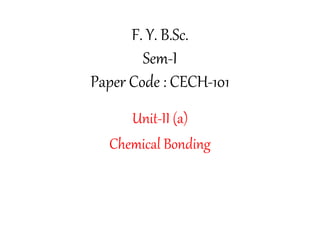
MO approach to metallic bond, conductors, insulators, semiconductors and superconductors
- 1. F. Y. B.Sc. Sem-I Paper Code : CECH-101 Unit-II (a) Chemical Bonding
- 2. MO approach to metallic bond and its Application • The theory is known as MO theory or Band theory.
- 3. MO for Metallic Bond or Band Theory • To understand the MO for metallic bond, the example of Lithium is taken here. • The electronic arrangement of Lithium atom is 1S2 2S1 2P0 the Li2 molecule exist in the vapour state and bonding occurs due to 2S orbital. • There are three empty 2P orbitals in the valence shell. The presence of empty orbitals reflects the metallic properties of it.
- 4. • Now, for Lithium, number of Atomic Orbitals(AOs) are more then that of valence electrons. So even if all electrons are used for bond formation, it can not achieve stable electronic configuration like inert gas. • Compounds of these types are called ‘electron deficient’. • Then, how the empty orbitals can be utilized in Lithium? • Either empty AOs of metals accepts the lone pairs from other atoms or ligands and make coordinate bonds or make cluster compounds by sharing of electrons with neighbor atoms.
- 5. • The MO of Lithium molecule have discussed earlier. There is 1 valence electron for each atom in Li2 molecule, that forms two MOs σ2S and σ2S*.But only σ2S makes bond formation possible. • Suppose that three Li atoms joined to from Li3. Three 2S AOs combined to form 3 MOs – one bonding, one non bonding and one anti bonding. • Non bonding MOs has energy between BMO and ABMO. • In Li3 the one BMO occupies two valence electrons and one non bonding occupies one valence electrons.
- 6. • In Li4, four 2S AOs combined 4 MOs- two BMO and two ABMO. • Two non bonding MOs are also there in between two BMO and two ABMO, that reduces the energy gap between them. • The 4 valence electrons are occupied by 2 lower energy BMOs. • As the number of electrons in the cluster increases, the energy gap between the orbitals decreases, when there are large number of atoms, the energy levels of orbitals are so close that they form a continuum.
- 8. • Since there is only 1 valence electron per atom of Lithium and MOs are two per molecule, there are only half filled MOs and half are unfilled. • Since the energy levels are so closed that it requires only minute amount of energy to jump the electron to unfilled MOs. • Now in MO, the electron have high degree of mobility, which is responsible for thermal conductivity and electric conductivity. • Conduction occurs because of two things: (a)MO extend over the whole crystal. (b) There is no energy gap between filled and unfilled MOs.
- 9. • Let we take the example of Beryllium. It has 2 valence electrons which fill the 2S valence band of MOs. • In Beryllium atom the energy gap between 2S and 2P is 160 kJ/mol. • As 2S AOs form a band of MOs, 2P also forms a band of MOs. • The upper part of 2S band overlaps the lower part of 2P band. Because of this overlap some of the 2P band is occupied and some of 2S band part is empty. There is possible and easy for electrons to perturb to unoccupied levels in the conduction band where they can easily move throughout the crystal. Beryllium therefore behaves as a metal.
- 11. MO approach to Conductors, Insulators & Semiconductors Conductors: • In Electric Conductors (metals), either the valence band is partly full, or the valence and conduction bands overlap. • Therefore no significant gap between filled and unfilled MOs, and perturbation can occur readily.
- 12. Insulators: • In insulators (non- metals), the valence band is full, so perturbation within the band is impossible. So there is appreciable difference in energy (called the band gap) between the valence band and the next empty band. • Electrons cannot therefore be promoted to an empty level in insulators.
- 13. Semiconductors: • Intrinsic semi conductors are basically insulators, where the energy gap between adjacent band is sufficiently small for thermal energy to be able to promote a small number of electrons from the full valence band to the empty conduction band. • The promoted electrons and unpaired electrons in valence band can conduct electricity.
- 14. • As temperature increases, conductivity of semiconductors increases, because number of electrons in conduction band increases as temperature increases. • The extrinsic semiconductors (n -type and p- type) are produced by doping the suitable impurity to intrinsic semiconductors.
- 15. Superconductors: • Metals are good conductors of electricity, and their conductivity increases as the temperature is lowered. In 1911 the Dutch scientist H.K. Onnes discovered that metals such as Hg and Pb became superconductors at temperatures near absolute zero. • A superconductor has zero or almost zero electrical resistance. • It can therefore carry an electric current without losing energy, and in principle the current can flow for ever. • There is a critical temperature Tc at which the resistance drops sharply and super conduction occurs.
- 16. • Later, Meissner and Ochsenfeld found that some superconducting materials will not permit a magnetic field to penetrate in their bulk. • This is now called the Meissner effect, and gives rise to 'levitation'. • Levitation occurs when objects float on air. This can be achieved by the mutual repulsion between a permanent magnet and a superconductor. • A superconductor also expels all internal magnetic fields (arising from unpaired electrons), so superconductors are diamagnetic.